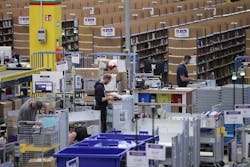Eaton Celebrates 39 Facilities for Achieving Zero Waste-to-Landfill
During World Environment Month, Eaton announced on June 27 that it is honoring 39 manufacturing facilities around the globe that have achieved zero waste-to-landfill status.
The 39 Eaton sites currently achieving zero waste-to-landfill include electrical, hydraulics, aerospace and vehicle operations and are located across Europe, Asia Pacific and North America.
Last year the company reduced its landfilled wastes by about 18%, or 4,900 metric tons, as part of a global zero waste-to-landfill program.
Since 2010, these facilities have eliminated a combined total of 2,750 metric tons of waste previously sent to landfills through efforts such as recycling, re-use, new work processes and other means.
Eaton is encouraging its manufacturing sites to achieve zero waste-to-landfill as part of its waste management program and also as a means to reduce the release of carbon dioxide (CO2), a greenhouse gas and potential contributor to global warming. Together, the 39 sites eliminated 2,500 metric tons of CO2, which is released during the transportation and storage of landfilled wastes.
“Waste reduction is environmentally responsible and the right thing to do for our plants and our communities,” said Harold Jones, Eaton’s senior vice president for Environment, Health and Safety. “Doing what’s right for the environment is part of our culture of doing business right.”
Eaton defines “zero waste-to-landfill” as consistently achieving a landfill waste diversion rate of 98% through either reuse, composting, recycling, or incineration – but only if the heat generated by incineration is collected and used in order to create more energy than was required for the incineration process.
Eaton zero-waste sites undergo an intensive audit process that includes verifying that at least 98% of a site's waste is diverted consistently for three months.
Eaton’s zero waste-to-landfill program began in 2010. Each facility developed plans that called for landfilled materials such as metal scrap, cardboard, pallets, plastic, general office trash and other wastes to be recycled, reused, converted to energy or eliminated from work processes.
“Projects such as zero waste-to-landfill help deliver the environmental performance that reflect Eaton’s commitment to be a leader in sustainable business practices,” Jones said. “And, we are striving to get better. Eaton has pledged to reduce GHG emissions by 25%, indexed to sales, by 2015. Programs such as zero waste-to-landfill will help us reach this goal. It all starts with our employees generating the ideas and enthusiasm to help Eaton do business right.”
About the Author

Adrienne Selko
Senior Editor - MH&L, IW, & EHS Today
Adrienne Selko has written about many topics over the 17 years she has been with Endeavor Business Media and currently focuses on workforce development strategies. Previously Adrienne was in corporate communications at a medical manufacturing company as well as a large regional bank.
She is the author of Do I Have to Wear Garlic Around My Neck? which made the Cleveland Plain Dealer's best sellers list. She is a senior editor at Material Handling & Logistics, EHS Today, and IndustryWeek.
Editorial Mission Statement:
Manufacturing is the enviable position of creating products, processes, and policies that solve the world’s problems. When the industry stepped up to manufacture what was necessary to combat the pandemic, it revealed its true nature. My goal is to showcase the sector’s ability to address a broad range of workforce issues including technology, training, diversity & inclusion, with a goal of enticing future generations to join this amazing sector.
Why I Find Manufacturing Interesting:
On my first day working for a company that made medical equipment such as MRIs, I toured the plant floor. On every wall was a photo of a person, mostly children. I asked my supervisor why this was the case and he said that the work we do at this company has saved these people’s lives. “We never forget how important our work is and everyone’s contribution to that.” From that moment on I was hooked on manufacturing.
I have talked with many people in this field who have transformed their own career development to assist others. For example, companies are hiring those with disabilities, those previously incarcerated, and other talent pools that have been underutilized. I have talked with leaders who have brought out the best in their workforce, as well as employees doing their best work while doing good for the world.
